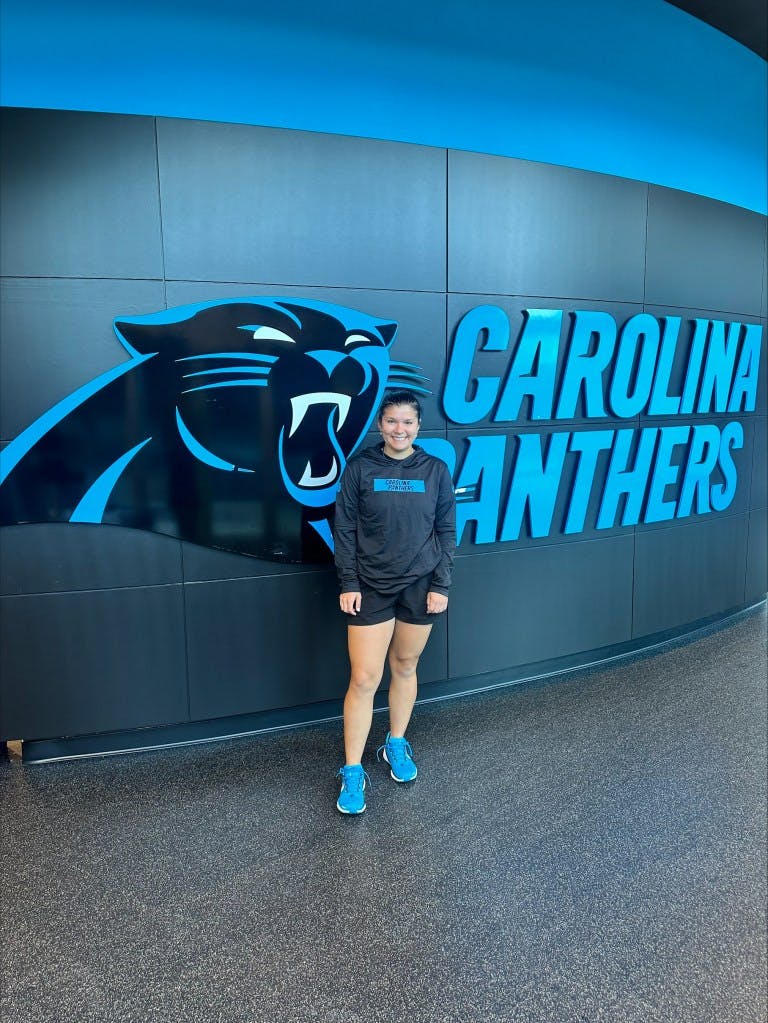While many students may not know the exact profession they want to pursue after graduation, those seeking a master’s degree in athletic training at the University of Georgia have a better idea than most after engaging in a multitude of hands-on clinical immersion opportunities.
As part of the master of science in athletic training program in the Mary Frances Early College of Education, every student must complete an eight-week rotation at a local high school under the guidance of a licensed athletic trainer.
“When we send these students out for these clinical immersions, we want them to get the best hands-on opportunity they can get,” said Bud Cooper, a clinical professor emeritus, who directed clinical learning experiences in the Department of Kinesiology for 16 years. “Keeping the number of students assigned at each clinical site to a low number, ensures that they’re getting that opportunity.”
During their rotations, students gain valuable clinical experience at local schools, including those in the Clarke County School District (CCSD), to acquire a variety of clinical skills, including injury assessment or treatment, injury rehabilitation, healthcare administration, and injury prevention.
These skills are developed in a cooperative learning environment with CCSD student-athletes and are vital to learning sports medicine techniques necessary for future athletic trainers.
Through the efforts of both the on-site licensed athletic trainer and the high school, graduate students in the program gain knowledge in healthcare by assisting a wide range of student-athletes, including athletes in football, soccer, baseball, tennis, lacrosse, wrestling, and more.
“It’s been a win-win situation for both UGA and CCSD because the athletic trainers that have been at those high schools are always happy to have extra help, and they’re also happy to teach and mentor,” said Cooper. “So that’s been a big plus for us to be able to offer them that experience.”
While some students are set on working with a collegiate or professional sports team, others are less sure of where they want to land in their desire to help others rehabilitate from injuries. The program’s clinical rotation at a local high school is a mandatory experience that engages students in a position they may not have previously considered as a possible career pathway.
“There will be students that are of the opinion that they never want to be a high school athletic trainer,” said Cooper. “They often have a desire to work at a college, or they want to work with a professional team, but after they do this rotation, they change their minds, and now they’re seeking out a position at a high school. So, it’s not for everybody, but it’s certainly for some people.”
Learning by doing

During her first fall semester in the program, graduate student Qwynn Marquez (M.S.A.T. ’26) worked at Clarke Central High School where she developed a deeper understanding of athletic training and how her work could make a difference in the lives of athletes both on and off the field.
“I loved my time at Clarke Central and enjoyed the student-athletes that I worked with,” said Marquez, who is completing a full-semester internship with the Carolina Panthers in the NFL this fall. “I grew up in a town and went to a high school that did not have a full-time athletic trainer, so it was already a unique experience in that aspect, and I realized the importance of athletic trainers in secondary school settings.”
Similarly, graduate student Lexy Keener (M.S.A.T. ’24) solidified her confidence in implementing concepts she learned in the classroom into real-world practice during her clinical immersion at Prince Avenue Christian School. Her experience also opened her eyes to the differences in the availability of resources between athletic trainers at the high school and college levels.
“Not only do high school athletic trainers have less supplies, but they also have limited time to spend with athletes to get treatment or rehab completed,” said Keener, who interned with the Orlando Ballet last fall. “For some of these high school athletes, their athletic trainers are the only access to medical care they get, so that can result in having to get creative and wearing many hats.”
The College’s two-year, six-semester athletic training program requires students to complete clinical experiences each semester, and the high school rotation makes up just a small portion of the experiential learning opportunities students receive throughout their time in the program.
Other opportunities include EMT training with the emergency department at Piedmont Hospital, as well as clinical rotations with orthopedic physicians, primary care physicians, physical therapists, UGA football and Olympic sports athletic trainers, and more.
“Throughout all my clinicals, my main goal was to learn as much as I could from as many clinicians as possible,” said Keener. “The main takeaway from my clinical experiences was that I am going to get out what I put in, so this meant stepping up to new situations and pushing myself to grow. I would not be the athletic trainer I am today without the vast array of clinical experiences I was exposed to, and I contribute it all to this incredible program.”